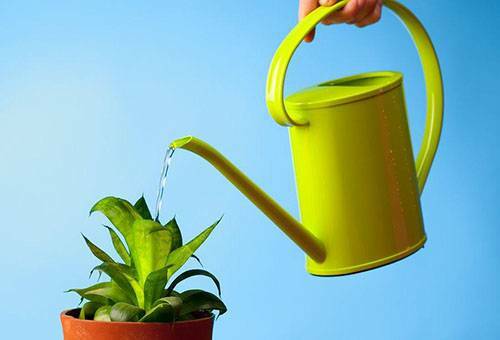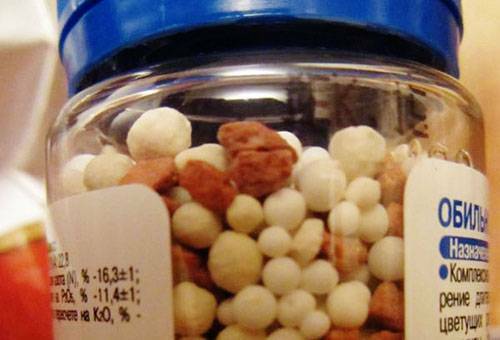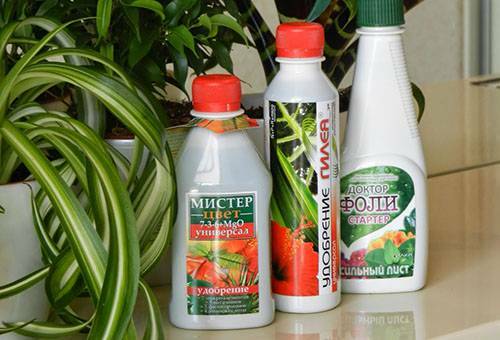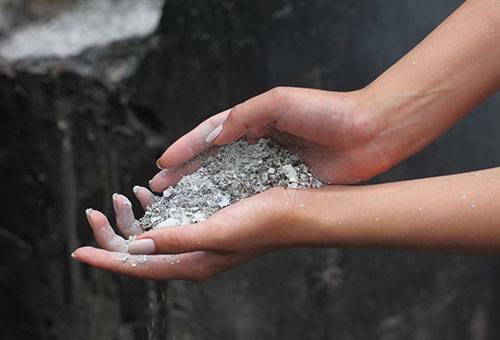Content:
- When should I feed the plants?
- Types of fertilizers
- What substances should be present in fertilizers?
- Folk recipes for fertilizers
Plants need not only a suitable level of illumination and compliance with the irrigation regime, but also regular feeding. Initially, the shop primer contains a certain amount of nutrients, but over time( for a couple of months) they are consumed, and additional fertilizers for houseplants are required.

When should I feed the plants?
The more active the fauna representative grows, the more he needs to feed. The period of the fastest and most intensive growth and development is that in the open ground, which occurs at home in the spring, a little less the plant is active in summer and autumn, in winter, there is a period of rest. But this does not mean that you do not need to feed flowers in winter, - fertilizer is required all year round, but with somewhat different intensity.
When a plant lacks nutrients, it signals this by its appearance:
- is pale as compared to normal coloring leaves, which often fade and fall, leaving the stems stripped;
- elongated, thin and weak stems;
- rapid and frequent pest damage;
- by inefficient flowering or its complete absence.
Not only a lack of nutrients is bad, but also their excess. An overdose of fertilizers can lead to growth disorders, diseases and even plant death. Cut flowers of over-fertilized plants are worse in the water.
The first time after buying or transplanting at home, it makes no sense to fertilize the flower. Typically, the nutrients initially present in the soil, enough for a month or two, depending on the size and intensity of plant growth. When the plant is weakened or sick, the concentration of fertilizer must be significantly reduced.

Types of fertilizers
There are fertilizers that are universal, useful absolutely to any flower, there are suitable for a certain group. Complex fertilizers contain a number of microelements and nutrients, which for many not very fancy colors can be enough. But a number of plants require additional nutrition with certain substances, for which domestic potassium, phosphoric and other fertilizers are already used at home.
Fertilizers can often be seen not only in liquid and powder form( later bred in water) form, but also in the form of rods, tablets, etc. Although at first glance this option seems convenient in use, with it nutrients concentrate in onethe place of the container with the plant, and in general the plant can continue to experience a deficiency of this substance.
Use fertilizer at home according to the instructions and recommendations on the packaging. There are indicated the types of flowers for which this fertilizer is used, and how and during which periods feeding is carried out. Many fertilizers, although not poisonous, but for the skin are not useful and easily cause irritation. Therefore, it is better to work with them in gloves.
Advice
It is better to use weaker fertilizer solutions at home more often than to use concentrated mixtures occasionally.
The main fertilizing of plants goes through the root system, i.e. by watering fertilizers or mixing them with soil. But a small amount of nutrients home flowers are absorbed and through the leaves - by spraying. When plants multiply, seeds, tubers or cut shoots are soaked in nutrient solutions. All this can be used only as a supplement, and not a substitute for radical top dressing.
Council
To water plants with nutrient solutions, if the soil in the pot is dry, it is impossible. Pre-moisten it with clean water.
If plants like high humidity and need frequent spraying at home, then basically they should be sprayed with clean water, only in 5-7 days you can use foliar top dressing. Otherwise, there is a danger of overdosing fertilizer and burns of leaves.

What substances should be present in fertilizers?
- Nitrogen - is necessary for plants to grow green mass - leaves. Without it, at home, they grow poorly, become flaccid, pale, even if there is enough light for the flower. This substance is involved in the construction of plant proteins and chlorophyll, without which plant life is impossible in principle. With an excess of nitrogen, there is an excessively dark color of the foliage, a delay in flowering and subsequent ripening of the fruit.
- Phosphorus - its disadvantage leads primarily to problems with the root system. It grows slowly, weakens, which affects the intensity of growth of the entire flower. The leaves acquire an atypical dark color with a slightly bluish tint. New leaves and flowers form slowly and grow small. In the case of an excess of phosphorus, the plant grows intensively, which can lead to a deficiency in the soil of other nutrients.
- Potassium - helps the plant absorb carbon dioxide and the atmosphere, and is important for the flowering process. When it is not enough, the flowers do not form at all or grow small. The leaves turn yellow or pale at the edges, begin to fall off. The plant's resistance to fungal diseases decreases.
- Sulfur - its deficiency leads to slowing or stopping growth, lightening the leaves. Special sulfur fertilizers are usually not injected into the soil, this substance is sufficient in the complex and phosphate fertilizers, in humus and manure.
- Calcium - is necessary for growth of roots and stems of a plant. With its shortage of tops, young shoots and leaves wither and die. The lack of this substance is especially bad for cacti and other flowers with dense spines.
- Magnesium and iron - are important components of chlorophyll. In case of problems with chlorophyll the plant can not photosynthesize in full, as a result its growth slows down, it becomes weaker. The leaves turn yellow and fade.
- Boron - affects the growth of the flower, when it is small, this process slows down or stops, young shoots may begin to die.
Advice
It is recommended to top-dress winter colors in 2-3 times compared to other seasons. Naturally, this does not apply to those plants that blossom or bear fruits in winter.
If in autumn the plants are discarded with leaves and shoots, leaving only roots or tubers, they do not need to fertilize and even water them in the winter. They are taken to a cool place with medium humidity until the beginning of the vegetative season.

Folk recipes of fertilizers
It is not always necessary to purchase special nutritional compositions. With the benefit of flowers, you can also use the most common products used by people at home regularly.
- Coffee grounds can be used to reduce the acidity of the soil. In addition, it makes the soil lighter, airy and loose, thereby improving the access of oxygen to the roots and reducing the risk of decay.
- Yeast can significantly stimulate growth. For 10 g of yeast add a tablespoon of sugar and dilute the mixture in a liter of water. When the solution has been infused for a couple of hours, it is still diluted with pure water in a ratio of 1 to 5 and watered the plants. However, potassium and calcium are involved in yeast fermentation, and the plant will have to compensate for their consumption.
- Onion husks are a rich source of microelements. It is boiled in boiling water, then allowed to cool and brew and use the resulting liquid for irrigation and spraying.
- More microelements are contained in the ashes. It can be added to the soil when transplanting plants and prepare a solution for irrigation( tablespoon of ash per liter of water).
- Nettle's infusion is used to fertilize depleted soil. Take 100 grams of leaves per liter of water, insist for a day, then filter and dilute with clean water in a proportion of 1 to 10.
- Sugar is useful to the plant for building complex organic molecules and as a source of energy for life processes. It can be dissolved in water for irrigation or simply in small amounts poured on the ground and then watered the plant. But in order to absorb sugar, and not lead to rot and fermentation in the ground, carbon dioxide is needed. Therefore, the soil must be regularly loosened and fertilizers used to increase the CO2 content. Even better in efficiency than sugar, one of the products of its decay is glucose.
- Plants in the open ground are often fertilized with cow dung and bird droppings. The same can be done for indoor flowers. Cow humus is dissolved in water in proportions of 1 to 10 and used for irrigation. Bird droppings are considered even richer in nutrients, and it is bred to a weaker solution( until a turbid greenish color is obtained).Among the disadvantages of such feeding is primarily the smell. In addition, plants can be infected with various parasites, sometimes and not harmful to animals, but harmful to the flowers themselves.

Regular fertilization of plants is a pledge of their beautiful appearance, stable growth, development and health. But besides this, it is necessary to observe the temperature-humidity regime, to monitor the level of illumination, the compatibility of different plants with each other and in time to treat domestic flowers from pests and diseases. And then flowers at home will be sure to please the eyes in winter and summer!
Read the article: cactus care



